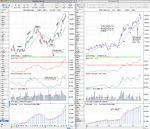isatrader
Senior member
- Messages
- 2,964
- Likes
- 135
My aim with this journal is to forward test Stan Weinstein’s four-stage breakout method that he describes in his book from 1988. As with hindsight, you can see that the method works beautifully to this day. However, it’s not as easy to make decisions at the right edge of the chart that look obvious with hindsight. So I plan to follow his method as closely as possible, but I’m also going to use point and figure charting methods for additional confirmation and to aid with the stage identification and breakout points.
I like to read a lot and have tried various methods over the last four years since I began to learn to trade and I imagine I’ve got many more years to go yet before I become consistently profitable. However, my goal in the short term is to try and develop my discipline and to stay focused while I test this method and not deviate from my plan. As I need to be consistent in my approach to see whether the system works or not, as otherwise I might disregard the method if I fail, when it was actually not the fault of the system, but my own short comings that caused the failure.
I’m currently on my third reading of Weinstein’s book as I’m keen to fine-tune my understanding of the four stages so that I can try to identify the A+ situations that he talks about, which are most likely to turn into the biggest winners over time and try to avoid the C- mediocre buys and false breakouts.
I won’t go into the whole method in this first post, but it is based on buying breakouts when the general market trend is positive; that are in the strongest sectors; that are breaking out into stage 2 with minimum overhead resistance; which have strong increasing volume on the breakout and also have good relative strength versus the market overall.
The method is based on buying stocks, but is also supposed to work just as well on commodities and indexes. However, from studying the charts I don’t think it is as suited to forex, although the stage analysis still seems to work very well, so I think it could still be a useful method in the toolbox for fx. But I’m going to limit my trades to stocks, indexes and commodities only to begin with and see how I get on.
I hope you enjoy the journal and I will appreciate any constructive feedback, especially from people that have tried the method or trade in this way.
Cheers
I like to read a lot and have tried various methods over the last four years since I began to learn to trade and I imagine I’ve got many more years to go yet before I become consistently profitable. However, my goal in the short term is to try and develop my discipline and to stay focused while I test this method and not deviate from my plan. As I need to be consistent in my approach to see whether the system works or not, as otherwise I might disregard the method if I fail, when it was actually not the fault of the system, but my own short comings that caused the failure.
I’m currently on my third reading of Weinstein’s book as I’m keen to fine-tune my understanding of the four stages so that I can try to identify the A+ situations that he talks about, which are most likely to turn into the biggest winners over time and try to avoid the C- mediocre buys and false breakouts.
I won’t go into the whole method in this first post, but it is based on buying breakouts when the general market trend is positive; that are in the strongest sectors; that are breaking out into stage 2 with minimum overhead resistance; which have strong increasing volume on the breakout and also have good relative strength versus the market overall.
The method is based on buying stocks, but is also supposed to work just as well on commodities and indexes. However, from studying the charts I don’t think it is as suited to forex, although the stage analysis still seems to work very well, so I think it could still be a useful method in the toolbox for fx. But I’m going to limit my trades to stocks, indexes and commodities only to begin with and see how I get on.
I hope you enjoy the journal and I will appreciate any constructive feedback, especially from people that have tried the method or trade in this way.
Cheers


